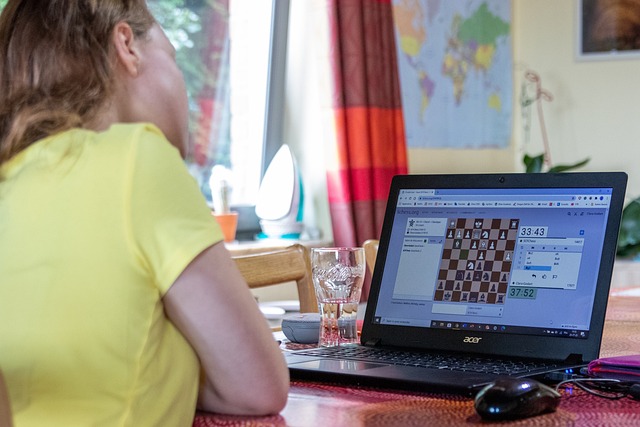Art therapy has embraced the digital age through online therapy platforms, offering accessible mental health support. These platforms break down geographical barriers, cater to diverse preferences, and provide flexible sessions. By leveraging technology, art therapists can reach a wider audience, engage clients with creative exercises, and ensure privacy through robust security measures. Web-based art therapy has proven successful in treating anxiety, depression, and trauma, enhancing mental health outcomes. Overcoming challenges, such as the digital divide, is crucial for delivering effective online sessions. The future of art therapy looks digital, with platforms transforming care and making therapy more accessible globally.
Web-based art therapy sessions have emerged as a revolutionary approach to mental health care, leveraging online therapy platforms to reach a wider audience. In today’s digital age, understanding the benefits of art therapy and its adaption to virtual spaces is crucial. This article explores various aspects of web-based art therapy, from setting up therapeutic environments and engaging participants interactively to addressing privacy concerns and showcasing successful case studies. Discover how these online platforms are transforming mental health services.
Understanding Art Therapy and Its Benefits in the Digital Age

Art therapy, an innovative approach to mental health support, has found new life in the digital age through online therapy platforms. This therapeutic method leverages creative expression as a means to explore and process emotions, thoughts, and experiences, offering a unique and accessible form of treatment. By engaging in art-making activities guided by a qualified therapist, individuals can gain insights into their psychological states and develop coping mechanisms.
The benefits of art therapy are manifold, from enhancing self-awareness and emotional regulation to fostering resilience and improving overall well-being. In the context of online therapy platforms, these sessions provide a safe and flexible environment for participants. They allow people with limited mobility or those in remote areas to access professional support, breaking down geographical barriers. Moreover, digital art tools and platforms offer diverse mediums and interactive features that can make sessions engaging and adaptable to individual preferences.
The Rise of Online Therapy Platforms: A New Frontier for Mental Health Services

In recent years, the digital landscape has witnessed a significant shift in how mental health services are delivered and accessed—the rise of online therapy platforms is a testament to this evolving trend. This new frontier in mental healthcare offers unprecedented convenience and accessibility for individuals seeking support from the comfort of their homes. With the increasing adoption of technology, many traditional face-to-face therapy sessions have seamlessly transitioned to virtual environments, making therapeutic services more readily available to a broader audience.
Online therapy platforms provide a safe and secure space for clients and therapists to interact through video conferencing, live chat, or other digital communication tools. This innovative approach breaks down geographical barriers, allowing individuals in remote areas or those with limited mobility to access specialized care. Moreover, the convenience of online sessions caters to busy schedules, encouraging more people to prioritize their mental well-being. As these platforms continue to gain popularity, they contribute to reshaping the mental health industry, ensuring that therapy is no longer confined to physical locations but readily available through various online channels.
Creating a Therapeutic Space: Setting Up Virtual Art Therapy Sessions

Creating a therapeutic space in a virtual setting is an essential step for art therapists looking to expand their practice through online therapy platforms. This involves carefully designing a digital environment that fosters trust, security, and comfort for clients. It begins with selecting a reliable video conferencing tool equipped with features like screen sharing, allowing artists to collaborate on creative projects remotely. The choice of platform should prioritize data privacy and security to ensure client confidentiality.
The virtual space should be free from distractions, mimicking the intimate atmosphere of an in-person therapy room. Therapists may use simple background images or tools to create a calming backdrop, while ensuring good lighting and audio quality enhances the overall experience. Establishing clear guidelines and expectations for clients regarding technology usage and privacy helps set the tone for successful online sessions.
Engaging Participants: Techniques to Make Online Art Therapy Interactive and Fun

Engaging participants in online art therapy sessions requires a shift from traditional in-person techniques to interactive and digital methods. One effective approach is to leverage the features offered by online therapy platforms, such as video sharing, screen recording, and collaborative whiteboards. These tools enable therapists to guide clients through creative exercises, like virtual paint-alongs or digital collage-making, fostering a sense of community and shared experience.
Additionally, incorporating games and interactive challenges into art therapy sessions can make the process more enjoyable and engaging. For instance, using online platforms to host virtual scavenger hunts where participants search for specific items in their environment and then create art based on their findings, or hosting themed drawing competitions with real-time feedback and voting. These dynamic methods not only enhance participation but also make online therapy sessions more accessible and appealing, ensuring clients look forward to each session.
Tools and Technologies: Exploring Web-Based Software for Creative Expression

The digital age has revolutionized art therapy, making it accessible through online therapy platforms and web-based software. These tools offer a unique blend of creativity and technology, allowing individuals to express themselves in new ways. From virtual canvas applications to interactive drawing boards, various platforms provide features like digital brushes, vibrant palettes, and even collaborative spaces, fostering creative connections.
Web-based art therapy sessions tap into this technological landscape, offering a convenient and engaging alternative to traditional in-person meetings. These online therapy platforms enable therapists and clients to work together remotely, ensuring continuity of care despite physical distances. With features like video conferencing, shared digital canvases, and secure file sharing, these tools create an immersive environment for artistic exploration and emotional expression.
Privacy and Security Concerns: Ensuring Safe Online Art Therapy Practices

Privacy and security are paramount concerns in the realm of web-based art therapy sessions, especially with the rise of online therapy platforms. As more individuals opt for remote mental health services, protecting sensitive personal information becomes a critical task. Art therapy often involves sharing intimate details and creative expressions, which can be vulnerable to potential breaches or misuse if not properly secured.
Online therapy platforms must implement robust security measures to safeguard patient data. Encryption protocols, secure login systems, and regular software updates are essential tools in this regard. Additionally, informing clients about privacy policies and obtaining their consent for data handling practices foster transparency and trust. Ensuring safe online art therapy environments is a collective responsibility, involving both service providers and users, to maintain the confidentiality and integrity of therapeutic interactions.
Case Studies: Success Stories of Web-Based Art Therapy Interventions

Web-based art therapy sessions have gained significant traction, with numerous success stories emerging from case studies across various platforms. These digital interventions offer a unique and accessible approach to mental health support, allowing individuals to engage in therapeutic practices from the comfort of their homes. Online therapy platforms provide a safe space for clients to explore their emotions through creative expression, facilitated by trained art therapists.
Case studies have shown that web-based art therapy can be particularly beneficial for those facing challenges related to anxiety, depression, and trauma. For instance, research has highlighted improved mental health outcomes in individuals who participated in online art therapy programs, with many clients expressing increased feelings of calmness, reduced stress levels, and enhanced emotional regulation skills. The flexibility and accessibility of these platforms cater to diverse populations, making therapeutic support more inclusive and convenient.
Overcoming Challenges: Common Issues and Effective Solutions in Virtual Art Therapy

Overcoming Challenges in web-based art therapy sessions is crucial for creating an effective and engaging experience. One common issue is the digital divide, where some clients may lack access to reliable internet connections or the necessary technology. To address this, online therapy platforms often offer multiple session options, including those with lower bandwidth requirements, and provide technical support to ensure a smooth experience.
Another challenge is maintaining confidentiality and privacy in virtual settings. Reputable online therapy platforms employ robust security measures, such as end-to-end encryption and secure data storage, to safeguard sensitive information. Additionally, therapists should clearly communicate their policies regarding data protection and privacy, fostering trust with clients engaging in these sessions.
The Future of Art Therapy: Integrating Online Sessions into Mainstream Mental Health Care

The future of art therapy looks set to embrace digital transformation, with online therapy platforms becoming an integral part of mainstream mental health care. This shift is driven by the increasing accessibility and acceptability of virtual sessions, particularly post-pandemic. Many clients now expect flexible, remote options alongside traditional in-person treatments, and art therapy is no exception. Online platforms offer a unique opportunity to reach a wider audience, especially those in rural or underserved areas, without geographical constraints.
Integrating online therapy platforms into the field of art therapy can enhance accessibility and inclusivity, ensuring that therapeutic benefits are available to more people. These platforms provide a safe and controlled virtual space for clients to express themselves creatively, engage in therapeutic processes, and receive professional support. With advancements in technology, we can expect even more interactive and engaging online sessions, potentially including virtual reality elements, to create immersive art therapy experiences.
